If you’re just getting started with your food preps, a home made $20 emergency food bucket is a great way to put up a lot of food quickly without spending a lot of money. Pre-made bucket kits can sell for as much as $200 online, and with a little bit of time and forethought you can build one yourself for a tenth the cost.
A single 5 gallon bucket can hold a months worth of food for one person. Imagine a a months worth of food security, shelf stable for 25 to 30 years, all with only a small investment in time, money and space. Easy enough. Here’s how to get started.
Choosing the Right Food
Your bucket will only last as long as it’s most perishable ingredient. Start by choosing foods that have a long natural shelf life and are calorie and nutrient dense so that they take up minimal space. While whole grains like brown rice may be great for your health, they contain natural oils that go rancid after about 6 months of storage.
Most people assume that white rice is all starch and empty calories, but a single pound contains roughly 1,650 calories and 32 grams of protein. An average adult needs 45 to 60 grams of protein per day, so that pound of rice is not just a great source of calories. It’s also providing at least half of your daily protein.
Rice is a great foundation, but for a balanced diet you’ll need beans as well. Beans and rice eaten together are a complete protein, and provide all the nutrition you’ll need out of a month of emergency food. While that may sound bland, know that there are literally dozens of varieties of both beans and rice that are inexpensive and easy to come by. Choose a variety you’re familiar with and enjoy.
Balancing Cost and Quality
While it may be tempting to buy the absolute cheapest option available, keep in mind that if you find yourself actually consuming the contents of your bucket in an emergency, you may regret that 85 cents you saved. If you shop around, you can find options that are both cheap and tasty.
A few minutes in the bulk grain isle of a warehouse store like Costco or Sams Club, and you’ll notice that there’s a pretty big variation in price by variety. Bargain basement white rice sells for as little as 30 cents per pound, but choosing something with a bit more flavor like basmati or jasmine rice increases the price to in the neighborhood of 50 cents per pound, and a few options sell for as much as 80 cents per pound.
A 5 gallon bucket can hold between 30 and 35 pound of rice, so choosing a 25 pound sack of mid-grade rice at 50 cents per pound sets you back about $12.50 but fills the majority of your bucket, leaving money to spare for other essentials like beans, salt and comfort items like drink mixes. Or, choose to go cheap with your rice at 30 cents per pound, spend a bit less and buy nicer beans. Take your pick.
Related: How To Buy and Store 260 Pounds of Food for just $83
Long Term Storage
Proper storage is key to ensuring your food is in good condition no matter when you need it. Even foods that have a long natural shelf life need a little help to stay fresh as long as possible. In an ideal world, you’d seal your food inside a 5 gallon bucket with a strong gasket around the rim, packed in mylar bags complete with oxygen absorbers. Vacuum sealed bags with oxygen absorbers are also a good choice. A good seal, and removing available oxygen are what ensure a super long shelf life.
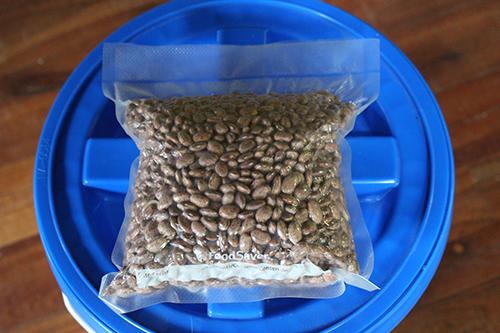
If you’re hoping to bring your costs down even more, you can skip the mylar bags with well sealed buckets, but know that you’ll need to update your inventory more often to keep things fresh. 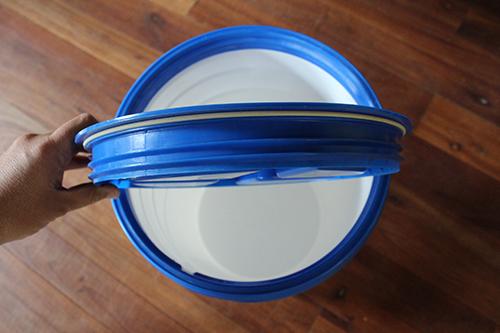 My family chose to invest in gamma seal buckets, that have a strong seal and unlike mylar buckets, they’re reusable and resealable.
My family chose to invest in gamma seal buckets, that have a strong seal and unlike mylar buckets, they’re reusable and resealable.
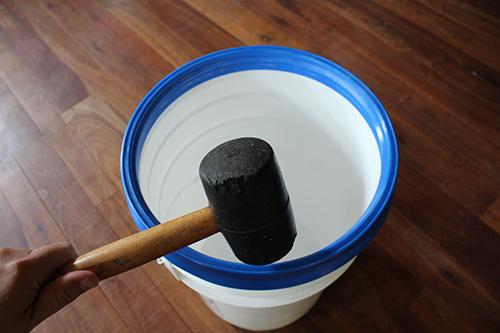
If you are using oxygen absorbers in your bucket, with or without mylar bags, add enough for 2000 to 3000 cubic centimeters of space. The air volume will vary based on how dense your food is, and how much air space remains. For all rice, you need 2000 cubic centimeters, so in a mixed bucket you’ll need to budget a bit more.
Packing a Survival Bucket
A pound of rice has about 1,650 calories and 32 grams of protein. Beans are almost as calorie dense at roughly 1,550 calories per pound, but contain 98 grams of protein. Bias toward rice to ensure you’re getting as many raw calories as possible.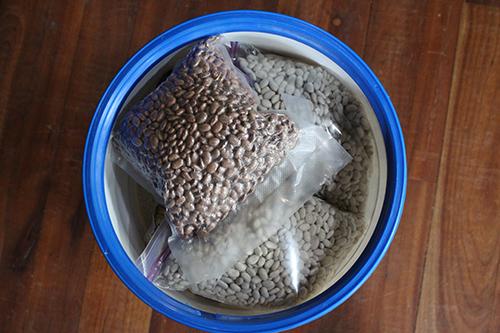
In my bucket, I’ve added:
- 25 pound sack of rice
- 8 pounds beans
- 1 pound salt
That’s it. In a pinch, that’s all you’ll need to survive, and enough salt to last you well beyond the beans and rice if you’re foraging to extend your supplies.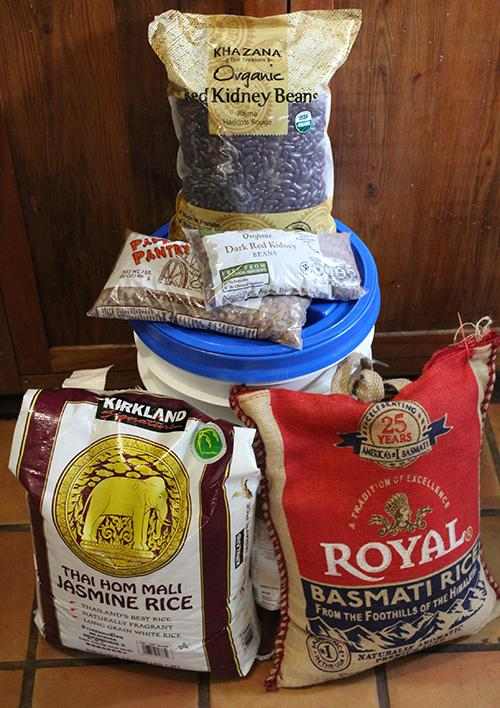
Other Considerations
Water Purification – While some survival buckets will include something to purify water, but when you’re packing beans and rice you’re making the assumption that you have fire to cook and a pot to cook in. Beans take between 1.5 and 2 hours to cook, so you’ll need a plentiful source of fuel. With that in mind, since you’re assuming lot of fuel anyway, it’s easier to just pack more food and assume you’ll boil your water.
If you really want something to quickly purify water, don’t choose bleach or pool shock where you’ll have to wait at least 24 hours to drink the water. Try iodine tablets, which are quick and easy, provide iodine, and sanitize water for immediate consumption.
Fire starters – Since you’ll need to cook to utilize your bucket, it’s a good idea to have some way to start fire. If the electricity is out and you’re bugging in, a propane stove will still work so long as you have a way to ignite the burner. If you end up out of your home, an easy means of fire starting will come in handy to cook your preps.
Cooking Utensils– A stainless steel cooking pot, properly nested in with the rice, wont take up much space in your bucket and will ensure that you have a good pot to use with your food stores no matter where you find yourself cooking. Also include a good fitting lid and a spoon, both stainless steel.
Shelter – A reflective survival blanket or poncho also doesn’t take up much space, and may just save your life if the weather is particularly wet, or can be used as shade in the desert. Consider your climate and think about any small items that may help you adapt in a pinch.
You may also like:
 50 Prepper Items To Shop For At The Thrift Store or Yard Sale
50 Prepper Items To Shop For At The Thrift Store or Yard Sale
World’s Smallest Battery Powers House For 2 Days (Video)
How To Make a Mini Root Cellar In Your Backyard In Less Than Two Hours

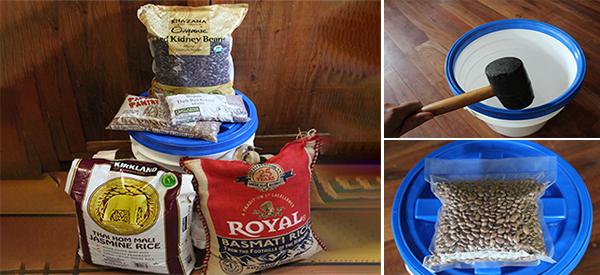












Back in 1974, my wife and son (2 years old) and myself lived in Costa Rica with the local people. We ate the same foods as they did – rice and beans along with a few fresh veggies (cabbage and tomatoes mostly). We adapted very easily and still have rice and beans (mostly black turtle) often. I find it is an excellent survives diet. A few spices, onions and garlic do liven it up considerable. In Costa Rica we ate this just about three times a day with no known health problems.
There is a danger in a diet consisting of mainly white rice. White rice has had the hull removed. White rice lasts longer than rice with the hull still on. However, like a lot of foods, the hull contains nutrients that the grain itself does not. A diet of white rice can easily lead to beriberi, a serious vitamin deficiency condition. I would suggest that in addition to beans and rice, to include enough of a multi-vitamin to provide your daily nutritional vitamin needs. This is especially true if you have children in your household as they are more susceptible to vitamin deficiencies than adults. While it is true that many third world countries exist on a limited diet, it is also true that the children in many third world countries suffer many nutritional deficiency conditions that have disappeared in late 20th century U.S.
he said 50% so you can ad beans or other things to your liking . white rice is the best staple hands down known for thousands of years. the chinese figured this out long before any thing you have ever heard of.
Good article. I enjoyed it and learned a couple of things.
Just thought I would post some vitamin deficiency disorders. They are as follows: Vitamin B1 deficiency can lead to beriberi. Vitamin B3 deficiency can lead to pellagra. Vitamin C deficiency can lead to Scurvy. Vitamin D deficiency can lead to rickets.
At the beginning of WWII, many volunteers for the armed services were rejected due to the presence of these vitamin deficiencies as a result of the hunger suffered during the great depression. Also many of the men were suffering from severe underweight problems. Today the reverse is true. Many volunteers for the armed services are rejected due to overweight problems.
Leftcoastchuck, what about sprouting the beans to boost the Vit C? I’d think some wheat (replacing up to half of the rice) which you can sprout would help; other sprouting seeds take little space and provide more nutrition. O2 absorbers should make the seeds last and last. All thanks to the authors, who took a challenge of how to assemble a very low cost food bucket, and no criticism meant.
DocJ: It is my belief, based on nothing but hearsay, that most beans that are marketed for eating have been treated with heat to prevent sprouting while in the package. You can imagine the retail value of buying a package of navy beans with half the beans with green growth sticking out of the beans. Or worse yet, brown sprouts because the sprouts, having started to grow died for lack of water, CO2 and sunlight.
That said, I think putting away seed beans to sprout and perhaps grow to sprouts and more beans would be an excellent idea. In addition, there are common plants that we all can eat. My wife and I are having a subtle war. I try to encourage the dandelions to grow, she is intent on digging out every one she spots. We haven’t had a meeting of the minds on dandelions yet. Perhaps I should gather the seeds for the EOTW. Dandelion greens can provide a lot of the nutrients that you need. Don’t know how much of each day’s worth and how many dandelion leave you have to eat in order to get that minimum, but they can. Cattails can do much of the same. There are many edible plants. The trick is to learn which are which because for every edible plant there are a lot more that are not only inedible but are dangerous to eat.
I have always wanted to know who was the first guy who was so hungry he took an artichoke apart and ate the heart and said, “You know, this would taste a lot better with garlic butter or mayonnaise”? The other question that has always bugged me is similar. Who was the first guy who sucked a snail out of its shell and just how hungry was he anyway?
I have sprouted a few beans from the supermarket and it worked ok. I buy a lot of stuff from the mormon Bishop’s Storehouse (you don’t have to be mormon, they also sell to gentiles) and those beans wheat and such are never treated, and very very good prices. They have O2 absorbers and all kinds of stuff. Your town may have one. Check local LDS churches, call the bishop and ask if there’s a storehouse close by.
You can also order from the Mormon Food Centers online. The website is: https://store.lds.org and a catalog can be found at:
http://tinyurl.com/mx5523a or
I’m a big fan of dehydrated beans …. more costly, but quick to cook. harmonyhouse.com has some … I’m not sure who else carries them.
Good point! Cook and dehydrate now while you have the time and power to do so. After SHTF, add hot water to re-hydrate and enjoy. Saves time, water and fuel.
Rabbits love to eat dandelions and rabbits are very tasty.
How long does a deficiency take to develop in an otherwise healthy person?
Ginny, I think there are too many variables that enter into the equation to give any kind of meaningful answer. I would think some variables would be your age, your general state of health, stress factors in your life, general sanitary conditions around you, things like that. Also, I believe, although I would have to do research to get more info, that the vitamin deficiency diseases don’t just go WHAM! and you are in full blown scurvy. Scurvy, I have read starts first with loosening of the teeth in the gums. So if you haven’t been pounding the Tang, the first thing you will notice is that when you bit down on that piece of really tough old coyote your tooth moved in your mouth. You reach up and, sure enough, it’s loose. Better start hitting the Tang again and start looking for more dandelion leaves. Osteoporosis is like that. You don’t even know you have it until suddenly the head snaps off your femur. In an EOTW situation, I would think you would be pretty well had. No world renown orthopedic surgeon to perform miracle surgery on your hip. You are now essentially a cripple and folks around you will be looking to put you in the pot along with what’s left of the coyote. How’s that for a grim outlook?
But there are natural sources of Vitamin D such as sunlight. The wonderful sun that gives you skin cancer also gives you Vitamin D for strong bones. Walking and weight bearing exercises also strengthen the bones. So if you have been covering 20 miles a day in your rounds hunting and gathering, during daylight hours, you probably are going to be doing enough weight bearing exercise and get enough sunlight to negate the osteoporosis that afflicts post-menopausal women. Modern postmenopausal women generally don’t spend as much time outdoor as they should. They generally aren’t carrying armloads of firewood nor do they carry the deer across their shoulders that was killed 3 miles from the campsite, all activities that you will be engaging in post-EOTW unless you are holed up in a deep cave living off your stored water and MREs for a year or more and are post-menopausal.
I am sure beriberi is like that. It creeps up on you. You need to recognize the symptoms.
Rickets the same way and pellagra. Research the deficiency diseases I have mentioned and see what the symptoms are. You do have general medical books in your prepper library, don’t you?
Interesting info, thank you. No I can’t carry that deer 3 miles but I’m working on it ? As for the medical books I’ve got a few but not sure how much they cover deficiencies – something to check out in my spare time and google if it’s not there. I need to devote some time to filing my latest batch of print outs.
I have been experimenting with cooking using a vacuum bottle. I purchased a wide mouth vacuum bottle and use it for cooking rice and steel cut oatmeal. First I boil water and fill the vacuum jar with the boiling water. I boil the water in the microwave. I leave the hot water in the vacuum jar for five minutes. For oatmeal I use 3/4 of a cup of steel cut oatmeal in the 20 ounce vacuum jar. After the water has been in the vacuum jar for five minutes I reheat it in the microwave for another 3 minutes and fill the rest of the jar with the rest of the hot water. I do this before going to bed at night. In the morning the oatmeal is cooked and to the temperature at which I like to eat it. It makes enough for my wife and me. I do the same with short grain semi-brown rice, only I use a half a cup of rice. I have done the same with lentils only I used a a half a cup of lentils and could have used a whole cup.
Why this method? I wanted to see if I could cook on the move. This method proves that instead of taking an hour to cook rice for a meal, I can prepare the rice in under 10 minutes and let it cook on the move. Same with lentils and oatmeal. The added advantage is that cooking rice and cooking oatmeal with the traditional method, in addition to being time consuming, gives off odors that a hungry person in the area can detect. Boiling water only gives off the smoke odor, or if you use heat tabs, not enough odor to be discernible. While whatever is in the thermos is cooking, no odor is given off. It also means I don’t have to stop long for meal prep. The food can be eaten directly from the thermos. The 20-ounce thermos makes enough for two.
Thanks for the idea! Hubby had a new SS vacuum flask given him for his bday. Never thought about using it for our steel cut oats but your suggestion is great. Then breakfast will be ready when we get up in the morning without the long lead time. Not a survival situation but good prep know-how.
A hay box cooker works on a similar principle if you aren’t on the move and it cuts down on fuel use and food odours. My solar oven works great for day cooking, put on in the morning, point at the sun and cooked when we come home in the afternoon. Again, no fuel use or food odour but no use on the move.
That’s exactly what I do. Make the set-up with the oatmeal just before I go to bed and it’s ready as soon as I get up in the morning, hot and ready to eat. No more, “Too late to make oatmeal. I’ll stop at Mickey D’s.” A lot healthier too!
With experimentation you can cook pasta and other beans. I haven’t experimented with other substances yet as I have only been working with this for a short while.
Just thought I’d add my two cents’ worth. Rice from the store will have insect eggs within it. Left on its own, they will hatch into larvae and rice weevils. The low oxygen environment of oxygen absorbers may kill them, or you can throw the bag into the freezer for 48 hours or so to kill them. Just bear in mind that on taking it out of the freezer, the bag will sweat, both inside and out, so make sure the rice is thoroughly dry before you store it. DO NOT USE the commercially available zip-lock bags, as they will degrade in storage, are not airtight, and become sticky, and may fall apart with time. I have had to throw away a LOT of stored rice and pasta because it had moisture in it and rotted or molded in the bags! >:P Just glad I found this out before SHTF!!!
Many food products are now packaged not only with oxygen absorbers to keep them fresh, but with silica gel in little packets to absorb the moisture. Have you experimented with silica gel packets to absorb the moisture? If you buy some pills they will have silica gel packets in the jar. I save them. Just before using them you can dry them by heating them at the lowest temperature in the oven.
Yes I have. I started putting in several silica get packets in after making sure my rice, etc. was dry. So far, so good, I think… I bought some mylar bags and O2 absorbers a couple of years ago to re-do some of my stash, but now can’t find them. Will be ordering some again soon. I just don’t trust the zip lock bags at all!!
Thanks for the tip on the eggs in rice. Have had this happen multiple times. Ruins the meal and the appetite. Will have to go check the rice already put up.
While writing these posts and thinking about it, I suspect that there is a whole long list of foods that can be cooked this way. Eggs can be hard boiled. Thin sliced meat can be cooked. Fish and fowl if sliced into small thin pieces could also be cooked this way. I haven’t experimented with other food stuffs such as vegetables. I think they would have to be diced pretty small but I could envision making a beef stew this way.
How do you get 25 pounds of rice plus all of that other stuff in a 5 gallon bucket???
I would guess that it’s cheaper to buy large bags then split it over 5+/- buckets so you can vary the flavours and have more than a month supply. Very cheap prepping.
A lot of good thoughts by all of you! Thanks. To continue cooking in the thermos, if the rice is hot, a scrambled egg can be added. Stirred in quickly, it will cook from the residual heat of the rice.
Dehydrated beans are available and although more expensive, they “cook” in about 10 minutes.
Even sealed in airtight, vacuum sealed bags, won’t white rice go rancid after no more than 5 years? We lived in the Middle East for 7 1/2 years and found this to be true. What am I missing?
Good thought, Cornflower. As a matter of fact, Japanese breakfast can consist of a bowl of freshly cooked rice with an egg broken over the rice and mixed in with the hot rice. Breakfast soul food for the Japanese people. Pretty much like eggs over easy on white toast for folks in the U.S.
And “left chuck roast,’ exactly how much water are you using in your thermos for the various items?
@broach68: Where in the middle east? That covers a wide area. Near the coast where it is not only hot but humid too or inland where the humidity is high when it reaches 10%? How fresh was the rice when it was first bagged? Was it vacuum sealed with oxygen absorber?
We buy Nishiki Gold rice in a foil bag that is nitrogen flushed. We usually wait and buy new harvest which means it is this year’s rice bagged fresh from the mill. If I were going to sock it away, I would leave it unopened in the foil bag. BUT the bottom line is at the ETOW rancid rice, while it tastes like kaka isn’t poisonous. Naturally if you have non-rancid rice that is preferable, but if all you gots is the rancid stuff, go for it. Obviously if your rice has turned rancid and the ETOW has not yet arrived I would feed it to the dogs with dog food or to cattle or even birds, although I don’t like attracting a bunch of birds. Sake is made by introducing koji, which is mold, into the hot rice, but now you have pretty much exhausted my data banks on sake making. And remember, that bleu cheese that tastes so good on your salad is moldy. In the days of sailing vessels, one of the big gripes of the sailors was moldy bread but they still ate it. Their bodies were accustomed to moldy food. We are not accustomed to moldy food, so we might need to start out lightly on moldy bread and cheese until we build a tolerance.
As for the amount of water I use. I use the Aladdin 20 oz. stainless steel, wide mouth thermos for my cooking experiments. I put the ingredients I want to cook into the thermos and then fill it to the top. That’s why there is a difference in the amount of rice and the amount of oatmeal. The rice takes up more water than the oatmeal. I used half a cup of lentils, but had water left over which I just poured off as I would if I had cooked them in a pan of water. The half cup of rice and the 3/4 cup of steel cut oatmeal absorb all the water and leave the food with the moisture content we like. I don’t know how much water to use with long grain rice which most Americans eat as I much prefer short grain rice. Most Americans like their rice a lot harder than I like mine. If I were starting out with long grain rice, not instant rice, I would put in a 3/4 cup of rice and fill the thermos with the boiling water. If there is too much water left after 8-9 hours, pour it off. If the rice is too dry, next time cut down on the rice a little and continue to fill the thermos with boiling water.
I haven’t moved to a larger vacuum jar and larger quantities, but I suspect if you can find a 1 quart large mouth thermos you can do the same thing. Large mouth thermos, of course, make extracting the food easier.
When I wrote it, the instructions seemed crystal clear. Coming back and re-reading my instructions on oatmeal and rice, I see it wasn’t clear, so I put the 3/4 cup of steel cut oatmeal in the thermos and then fill the thermos with boiling water to the full mark. Same with rice. I keep harping on steel cut oats because I haven’t cooked Quaker Oats oatmeal and with the instant oatmeal, you just add hot water to them anyway, no need for the thermos and all that. I know nothing about instant rice.
Sorry for not writing more clearly. It made perfect sense to me the first time I re-read it. Too bad we can’t go back and edit some of our posts. Some of mine sure need it. Predictive does me in sometimes. I am finally learning to go back and re-read what I wrote before I hit “Post”.
Another good place to buy storage food is restaurant supply stores. Cash & carry and URM in this area. They’re open to the public and don’t bat an eye at somebody buying 400lbs of rice and 200lbs of beans. And they have a lot of other stuff.
also, even though it seems bad to think about, even if you get the bugs in your grains/flour/pasta, they’re just extra protein; they won’t hurt/kill you if you eat them. when my rice starts hatching, the boiling cooking water kills them and they rise to the top of the pot and i just skim them off. this is why flour was sifted before using, but again, can be eaten if buggy. i notice that the bugs show up if my flour has gone rancid as well. then i toss. now i keep the open bags in the fridge since i don’t use it as fast as when kids were eating at home.
The guests at Hanoi Hilton during our Vietnam follies were quite pleased to find weevils and other insects in their rice gruel. It meant added protein to their otherwise low protein diet. Similarly, guests of the Imperial Japanese army during WWII spent a lot of free time hunting down various insects and , again, were pleased to find weevils in their rice.
I just recently read an article espousing growing insects for protein. According to the article, insects are rich in protein and are an efficient source of protein. You get more bang for the buck from a pound of grasshoppers than you do from a pound of top sirloin. While I can accept the principle, I am not yet prepared to abandon the meat department at my local grocery store for the insectary.
yes. insects are a staple food around the world. i’ve even considered “farming” such ones as crickets and meal worms (forget which beetle they are just now), even bee larvae are edible, but i’d spare the bees. even earthworms can be grown (vermicompost) and eaten in a pinch. i venture that if “they” came looking for your food stores (FEMA or other “friendlies”), they’d overlook/pass by those particular foodstuffs. remember that john the baptist ate locusts and wild honey (and i’d bet a few bee larvae) while surviving in the desert. still, i prefer ground beef over ground earthworm myself. if i ever get the opportunity (money) i’d like to build an onsite fish pond so that the crickets and mealworms could feed the fish. chickens would appreciate all of them too, especially live. if i had the opportunity for that, i’d also want to buy a freeze dryer to preserve and store overgrowth populations for these above aforementioned, otherwise preferred protein sources.
this, of course, has to wait until publisher’s clearing house sends me the check they keep promising me for years now. 😉
Way back when Johnny Carson was on late night TV at one time there was a rumor that Mickey D’s hamburgers were ground up worms rather than ground beef. Johnny quickly put the lie to that rumor by pointing out that at the time worms were like $15.00 a pound whereas ground beef was 79¢ a pound and it didn’t make too much economic sense for Mickey D to sell $4.00 worth of ground up worms for $1.25. I don’t know what kind of emolument Johnny got from Mickey D for putting the lie to the rumor but I am sure they were very grateful. Free quarter pounders and fries any time he felt like stopping by?
Wasn’t there a movie where the star of the movie ate a handful of crickets? Michael somebody strikes me as the star and he was some sort of ghost haunting a house. My recollection of the movie is probably wrong, but I seem to recall a scene where he grabs a handful of crickets and stuffs them in his mouth with a few getting loose.
Diane, I think you are 100% correct that if marauders of whatever ilk came by looking for food and demanded to know where you had your stores hidden and you grabbed a handful of crickets or meal worms and stuffed them in your mouth and said, “Here’s dinner. how many handfuls do you want?” If they didn’t barf on the spot, they would quickly leave and go somewhere else. Might even be good camouflage for the canned steak you have hidden. Big aquarium of meal worms inside the front door for you to scarf down in front of the FEMA gestapo and offer them a handful. “These are the protein and the dandelion leaves are the Vitamin C and other nutrients. Do you want me to show you how to dig them up?” I am going to have to put that in my EOTW notebook to follow up on.
i’m not a big movie watcher, so i’m not familiar with the one you are referencing regarding crickets. i know there is a kid’s book i read when i was one, that is about a boy who takes a bet (and loses) where the consequence is he has to eat one (or more?) worm/s a day for a month, and the various ways he went about doing it. he was monitored to make sure he actually ate them. i also remember reading another (kid’s) story about a man in the arctic who got stranded w/no food and survived by eating mice. he learned how to catch them by watching the foxes. so while i’m at it, i guess i could raise mice too. may as well raise snakes and rabbits. they’ll all feed each other and me as well. okay. i’ll share the clover and dandelions with the chickens, rabbits, mice, crickets, meal and earthworms, while the bees will ensure we have plenty of them, and all the other edible weeds FEMA et al will pass right by.
I believe the actor was Michael Keaton and the film was Beetlejuice. According to the list I consulted it was listed as his worst film. That may be one reason why you don’t remember it. It was very forgettable.
Sorry to hear! Its my favorite movie!
Thanks everyone for your great tips. I’ve only been prepping for about 7 yrs. Still learning!
It was Michael Keaton in ” Beetlejuice” (sp?).
Love all the great info you guys share! I’ve only been prepping for about 7 yrs so still learning.
Many years ago when my brothers were in the U S Navy and at sea for long periods of time, they told that their fresh baked bread always had weevils in it and they just spread butter over it and ate it with no harm at all.
How to you fit all that rice into that bucket. Rice looks bigger than bucket.
Just like you get more sugar or salt or anything in a jar. You will it and then tap it on the sides and gently bang it on your work surface. If you fill a jar with sugar and perform the above exercise you will be surprised how much more you can add to the jar. Same with rice. In essence you jiggle the rice to fill spaces. You can even pack more in mylar bags if you perform the same exercise.
I need to shed light on this whole beans and rice thing. I’m not going to talk about nutrition except to say (Hmm, I guess I am going to talk about it after all) that this is a very filling combination. And rice can also be “spiced up” with a pouch of Lipton’s Onion soup mix, chicken or beef bullion (cubes or granules) or a little onion powder or other seasoning. If you stock some cans or pouches of meat, like chicken, tuna, ham or Vienna sausages, you can eat them with your rice. As far beans being bland, that’s because you’re not making them right. I am used to eating red, pink, black and even white kidney beans, both the large and small ones. Go to any grocery store and buy Sazon, Adobo, or onion and garlic powder, even salt free Mrs Dash and season those beans, add a little tomato sauce or ketchup. If you have onions and green peppers, dice a bit and toss it in and you’ll have flavorful beans. It’s also common to drop in a few pieces of potato or ham. I like to drop in a little bit of ground beef or turkey.
Although the point of one bucket and a low price isn’t lost on me, for the sake of one’s health and comfort, it might be more realistic to fill a second bucket with other foods or even reduce the amount of rice or beans slightly in order to increase variety in a single container. A second bucket of Soy sauce, honey, sugar, salt, dry milk, etc., would provide other long life staples. Realistically, nobody wants to eat the same damn thing or couple of things everyday or even for just a week
I had to eat tuna sandwiches for four days during a power outage. It was a full year before I could even look at one without feeling like hurling.
I am 65 yrs old and grew up poor. There were 10 in my family and my dad worked as a night watchman for a construction company so very low pay. We ate whatever we could hunt, grow or beg from neighbors to have any kind of meal. And bought the cheapest food available in the largest containers. I used to take peanut butter sandwiches to school for months and was lucky to have it. Sometimes it was the only meal for the day. I have carried that frugality all my life and teach my sons and grand kids the same. If I am still around when SHTF you can bet me and my family will be surviving on whatever we find and there will be no complaining whether it was the same meal 6 months in a row or not. My parents lived through the depression and taught us to appreciate the small things. If you are hungry enough you will eat those BORING meals if it means you get to live another day. And learn to thank God there was food to have.
Toss some bullion cubes in the bucket in a separate bag for flavor and added nutrients
For survival soup… barley, beans, lentils, split peas, garbanzo beans, macaroni noodles etc… can I mix all the dried items except the rice into one 5 gallon bucket with mylar and oxygen absorbers? Or is there a problem with mixing those specific dried ingredients? There wont be any salt or bouillon added to the bucket. THanks!
Deixem a quantidade de feijão que vão fazer de molho a noite, no dia seguinte escorra a agua com espuma ,lave bem e poe na pressão por 20 minutos que fica pronto.Cubra de agua o feijão na panela 2a 3 dedos acima.Se sei feijão for muito novo idem acima e deixe na pressão apenas 5 minutos e desligue.Tá pronto. É assim que fazemos no Brasil.